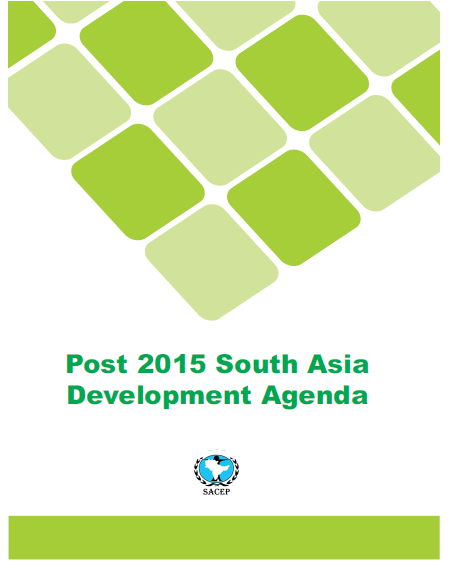Post – 2015 South Asia Development Agenda: A Report by South Asia Co-operative Environment Programme
 On 26th June 2014 at the First United Nations Environment Assembly (UNEA), the “Post 2015 South Asia Development Agenda” report was Launched by the South Asia Co-operative Environment Programme (SACEP) in collaboration with United Nations Environment Programme (UNEP). South Asia with its eight countries – Afghanistan, Bangladesh, Bhutan, India, Maldives, Nepal, Pakistan, and Sri Lanka – is amongst the fastest growing and vulnerable sub-regions of the world. The report not only highlights the key challenges but also analyses the critical means of implementation of the Rio+20 outcomes along with its policies and programmes. Ensuring sustainable development and growth of the South Asian sub-region goes beyond the scope and span of individual countries,It requires regional cooperation and global actions to pave the path for economic and social progress addressing concerns of employment, growth as well as strengthening environmental protection.
On 26th June 2014 at the First United Nations Environment Assembly (UNEA), the “Post 2015 South Asia Development Agenda” report was Launched by the South Asia Co-operative Environment Programme (SACEP) in collaboration with United Nations Environment Programme (UNEP). South Asia with its eight countries – Afghanistan, Bangladesh, Bhutan, India, Maldives, Nepal, Pakistan, and Sri Lanka – is amongst the fastest growing and vulnerable sub-regions of the world. The report not only highlights the key challenges but also analyses the critical means of implementation of the Rio+20 outcomes along with its policies and programmes. Ensuring sustainable development and growth of the South Asian sub-region goes beyond the scope and span of individual countries,It requires regional cooperation and global actions to pave the path for economic and social progress addressing concerns of employment, growth as well as strengthening environmental protection.
The South Asian Agenda for Sustainable Development has identified the following four key priorities:
- Eliminating Poverty: It specifies the need to adopt a three-pronged strategy of accessibility, affordability and availability to – address the problem and impacts of a growing population in conjunction with creating human security.
- Conserving Natural Resources: The extreme pressure exerted by an incessantly growing population, rampant urbanisation and vast industrialisation on natural resources needs to be arrested. Actions towards building resilience against climate change and managing urbanisation amongst others have been urged to take up.
- Securing financial and economic base: Promoting technology and knowledge transfer, developing a sub-regional trading block while reducing the dependence on external aid are some of the means of strengthening the economic and financial base of the sub-region.
- Strengthening institutions: In order to address the above three challenges, necessary policies and regulations need to be implemented across the sub-region across all levels, sectors and stakeholders. These measures need to be built around the national and local imperatives in the sub-region to generate mutually reinforcing benefits.
The report was prepared by Development Alternatives (DA) for SACEP through a participatory process in consultation with the concerned line ministries of member countries, inter-governmental organisations, international organisations, expert institutions and civil society organisations.
It has identified strategies for Green Economy to contribute to poverty eradication as well as sustained economic growth, enhancing social inclusion, improving human welfare and creating opportunities for decent work for all while maintaining a healthy ecosystem. These strategies must be ambitious, action‐oriented, collaborative and also adaptable at different levels of development. The report recommends actions in the following areas that are needed to achieve sustainable development and a greener economy in the South Asian sub-region:
- Political commitment leading to reformed policies, legislation and schemes, and improved environmental governance
- Stakeholder partnerships, specifically community participation; private sector investment and involvement
- Incorporating sustainability in education and focus on vocational education and capacity building programmes
- Innovation with increased Investments in Research and Development and in infrastructure
- Investments in knowledge management, technology transfer and financial arrangements across the 8 countries
- Regional cooperation in sharing best practices for resource management and strengthened implementation systems.
The full report is available on the website of SACEP (Recent Publication): http://www.sacep.org/pdf/post2015_sada.pdf




Leave a Reply